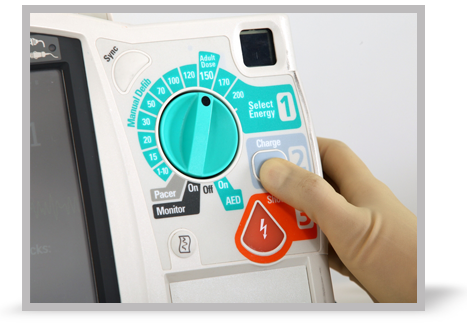
- Next steps

Feedback
That is not quite right.Feedback
No, that is not quite right.
The correct treatment for this patient is to give up to three synchronised DC shocks. Please refer to the topic “How to perform synchronised cardioversion”.
Defibrillation is not appropriate because this is not pulseless VT and a synchronised shock is therefore required.
If the patient does not respond to this then you should administer amiodarone 300 mg IV over 10-20 min. This should then be followed by 900mg of amiodarone over 24 h.
It is important to ensure that the patient’s electrolytes are normal and that you correct all reversible factors that may predispose to further arrhythmia. Ensure that appropriate further expert help and advice is obtained at the most appropriate time for the patient.
Feedback
That is not right.Feedback
No, that is not right.
The correct treatment for this patient is to give up to three synchronised DC shocks. Please refer to the topic “How to perform synchronised cardioversion”.
Defibrillation is not appropriate because this is not pulseless VT and a synchronised shock is therefore required.
If the patient does not respond to this then you should administer amiodarone 300 mg IV over 10-20 min. This should then be followed by 900mg of amiodarone over 24 h.
It is important to ensure that the patient’s electrolytes are normal and that you correct all reversible factors that may predispose to further arrhythmia. Ensure that appropriate further expert help and advice is obtained at the most appropriate time for the patient.
Feedback
Yes, that is right.
The correct treatment for this patient is to give up to three synchronised DC shocks. Please refer to the topic “How to perform synchronised cardioversion”.
Defibrillation is not appropriate because this is not pulseless VT and a synchronised shock is therefore required.
If the patient does not respond to this then you should administer amiodarone 300 mg IV over 10-20 min. This should then be followed by 900mg of amiodarone over 24 h.
It is important to ensure that the patient’s electrolytes are normal and that you correct all reversible factors that may predispose to further arrhythmia. Ensure that appropriate further expert help and advice is obtained at the most appropriate time for the patient.
References
See chapter 11 of the ALS manual for further reading about the tachycardia algorithm.
Essentials: Case study one – ABCDE and ECG results
The patient’s ABCDE results:
A : Clear
B : Spontaneous breathing, rate 26 min-1;
C : Looks pale, HR 200 min[sup]-1[/sup]; BP 70/42 mmHg, CRT 3 s
D : Alert, glucose 5.6 mmol l[sup]-1[/sup];
E : Nil of note
You can see the patient’s ECG rhythm strip here.

Algorithm: The tachycardia algorithm
The tachycardia algorithm is available in chapter 11 of the ALS manual.

